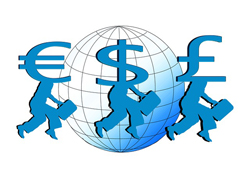 Are you thinking about setting up an e-commerce site or selling products worldwide? If so, you may want to consider providing users with currency conversion.
Are you thinking about setting up an e-commerce site or selling products worldwide? If so, you may want to consider providing users with currency conversion.
Currency conversion lets your web visitors convert international currency prices to their home currency when checking out products on e-commerce sites. It also allows your visitors to see the exact amount their card or PayPal account will be charged, expressed in their local currency.
The obvious advantage of adding currency conversion is that it allows your customers to view and understand pricing in foreign countries in their own home currency, making it it easier for purchasers to work out their costs and expenses.
If you are a WordPress user, you can add a currency converter to WordPress, allowing your customers to quickly perform currency conversions to determine the cost of your goods.
Currencyr – Free Currency Converting Tool For WP Websites & Blogs
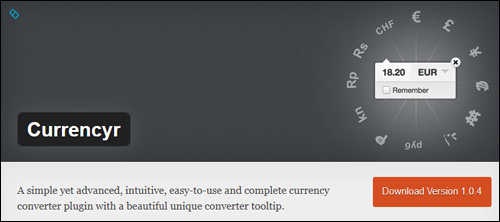
Currencyr is an intuitive, easy-to-use and complete currency converter WordPress plugin with a unique converter tooltip. And, it’s completely free to install and use on your WP web site.
This useful plugin features:
- Inline converter
- Supports various exchange rates providers, like Yahoo!, Google, Open Exchange Rates, European Central Bank and FoxRates
- WP-Cron task scheduler enabled
- Widgetized currency table and converter
- Supports integration with a number of e-commerce plugins such as WooCommerce, WP-eCommerce and Easy Digital Downloads.
- Can determine local currency automatically
- Full language translation support
Important: This plugin requires PHP 5.3.0 or later. Do not install this plugin if you currently have an older version of PHP installed. Alternatively, ask your webhosting provider to update your PHP.
***
You can install the Currencyr plugin from your WordPress admin area by searching for “currencyr” in the Plugins section and clicking “Install Now” …
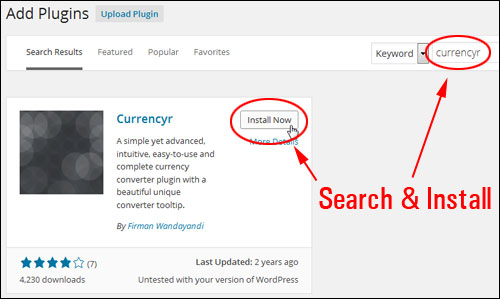
After installing and activating the plugin, you can get to the plugin’s settings area by selecting Currencyr from your admin navigation menu …

The plugin settings area offers you a number of configuration options …
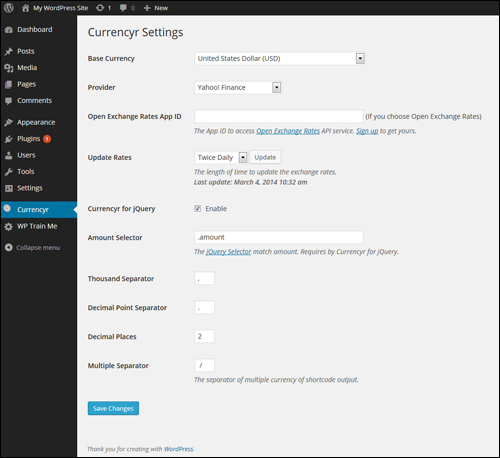
For example, you can select your base currency from a dropdown menu if you prefer to use a different currency than the default option ’United States Dollar’ …
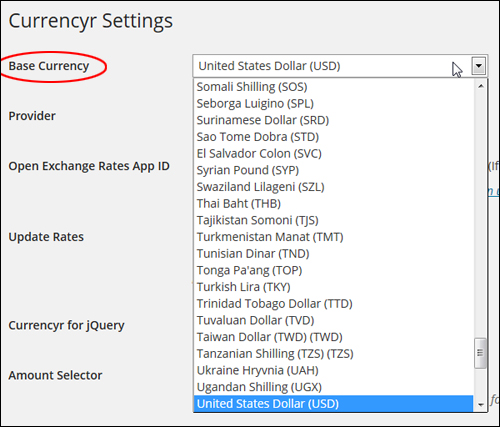
Similarly, you can specify which data provider you want to use from the drop-down menu in the ‘Provider’ section. The default option is ‘Yahoo! Finance’, but you can also choose one of the other options, like European Central Bank, FoxRate, Google Finance or Open Exchange Rates …

Note: If you choose Open Exchange Rates as your provider, an API (Application Programming Interface) is required …

You can choose how often you would like to update the exchange rates by selecting an option from the ‘Update Rates’ drop-down menu …

The Currencyr plugin uses jQuery, which allows web developers to add things like animation effects to web applications (like WordPress plugins).
If you have no reason to edit the jQuery settings, just ignore this option …

Configure the remainder of the settings to suit your preferences and remember to click Save Changes when finished …
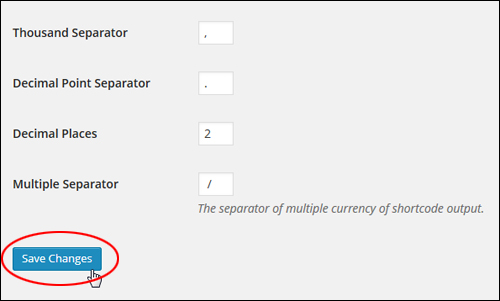
After you have finished configuring your plugin settings, you can easily start adding currency conversion to WordPress pages and posts using a shortcode.
See the ‘Additional Plugin Notes’ section at the end of this tutorial to learn more about using currency codes (e.g. USD, AUD, ZAR, etc …) with the Currencyr plugin.
How To Use Shortcodes
You can insert currency conversion into WordPress posts, pages and widgets with no web coding knowledge using shortcodes.
Below are some examples of currency shortcodes that you can add to pages and posts:
Let’s say that you are selling a product for a fixed price (e.g. $175) in US Dollars (USD), and you would also like to display your amount converted into British pounds (GBP) on your page.
All you need to do is insert the following shortcode into your post or page …

Note: You can also insert amounts in dollars and cents (e.g. 165.49, 189.00, 2499.99, etc …)
The example below shows how the shortcode looks once you have inserted it into your post or page …
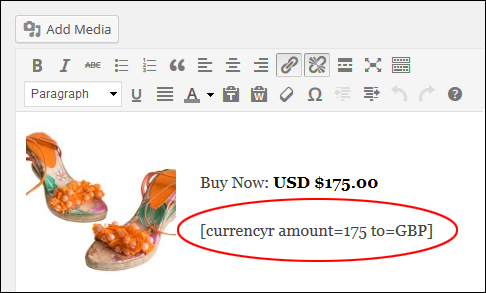
When your post has been published, your currency conversion will then display like this …
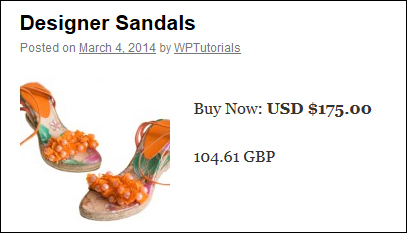
Using this example, let’s also display the same price into multiple currencies.
To do this, use the shortcode below (you can add as many currency symbols as you like separated by vertical pipes) …

The example below shows how the above shortcode appears when inserted into a page …

After publishing the post or page, your converted currency amounts will then display as you can see below …
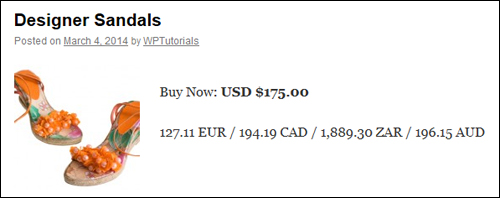
See the ‘Additional Plugin Notes’ section below to learn how to change the currency separator symbol in this plugin.
Now, let’s say that you would like to select a different base currency than the one selected as the default.
For example, if you have specified your default base currency as EUR and you have a section on your site targeted to visitors in countries like Australia or Canada, you can change the base currency using the following shortcode …

The example below now shows how the shortcode appears when you add it to a post …
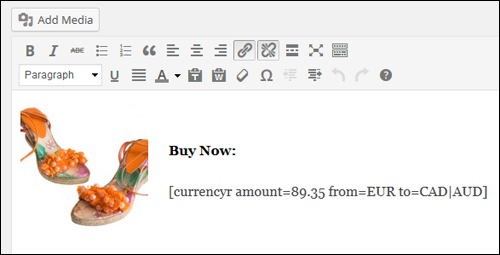
Once the page or post has been published, the currency conversion will then display like this …

How To Use The Widget
You can also add currency conversion to your website’s sidebar using a widget.
To add currency conversion to your sidebar, select Appearance > Widgets in the WP user admin menu …
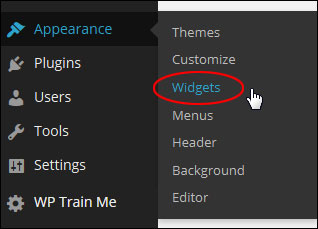
In the Widgets > Available Widgets section find the ‘Currencyr’ widget and add it to an Active Widgets location …
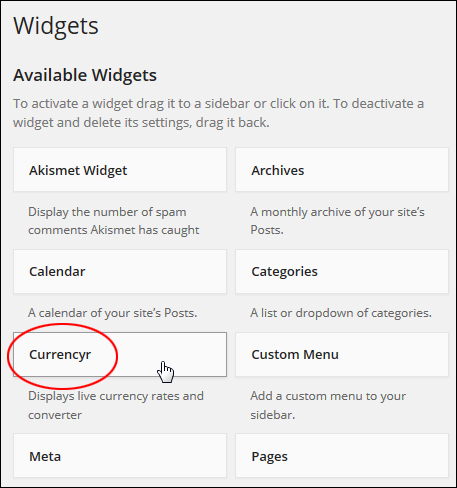
Configure the widget options as shown below (add currency codes separated by commas), and click ‘Save’ to save your settings …
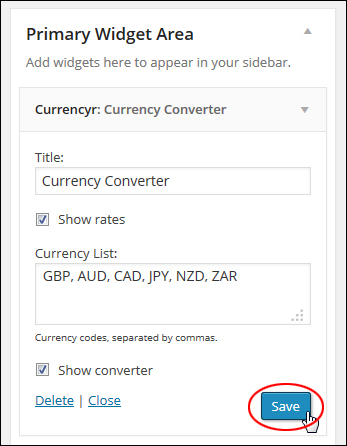
The currency converter tool will now show on your website’s sidebar menu with the settings you have selected …
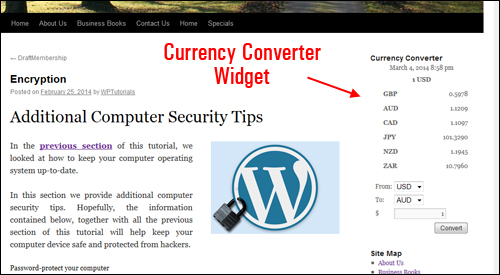
Additional Plugin Notes
This section contains additional information about using the Currencyr plugin.
Currency Separator
The Currencyr plugin lets you specify a symbol of your choice to display as the currency separator when using multiple currencies.
You can select a different symbol in the Multiple Separator settings section.
So, for example, entering the default symbol “/” (forward slash) …

Separates all your prices using a forward slash as you can see in the example below …
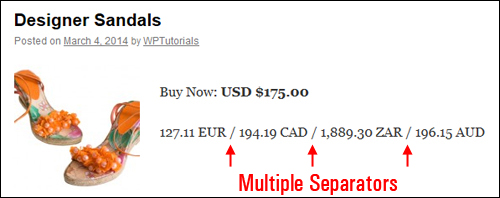
If you enter another symbol and update your settings …

Your web site visitors will see the new symbol being used as the currency separator …
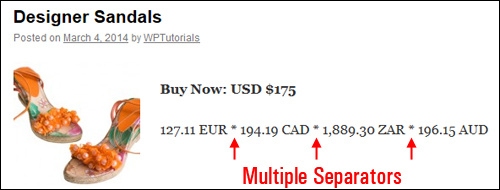
E-Commerce Software Integration
As stated earlier, the Currencyr plugin integrates with various WordPress-compatible e-commerce plugins such as WP-eCommerce, Shopp, and Easy Digital Downloads …
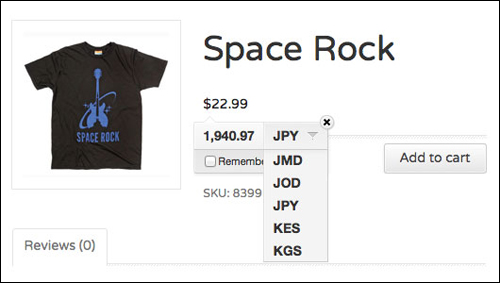
(image sourced from Currencyr plugin website)
And there you have it! Now you know how to easily add currency conversion to your WordPress web site.
To learn more about WordPress e-commerce plugins, see the tutorial below:
***
"These tutorials have so much information and are easy to understand. If you use WordPress or plan to in the future these will help you with everything you need to know." - Valisa (Mesa, Arizona)